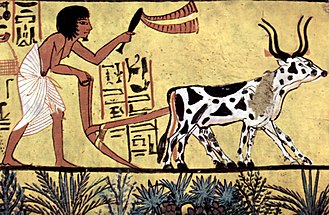Plough






Plough or plow (American English) is a farming tool used for turning over the soil to bring fresh nutrients to the surface, as well as to bury weeds and the remains of previous crops. Ploughs were traditionally drawn by working animals such as oxen and horses, but in modern farms, they are pulled by tractors. A plough may be made of wood, iron, or steel frame with an attached blade or stick used to cut the earth. It has been a fundamental instrument for most of recorded history, enabling agriculture to flourish by making the soil more fertile and reducing the time needed to prepare the land for planting.
History[edit]
The plough has a long history that dates back to the Neolithic Age. Early ploughs, known as ard or scratch ploughs, were made of wooden beams and were pulled by oxen. These ploughs were simple and could only scratch the surface of the soil. The introduction of the iron ploughshare in the Iron Age significantly improved the efficiency of ploughing by allowing deeper tillage of the soil and the ability to cut through denser vegetation.
The development of the mouldboard plough in the Middle Ages was another significant advancement. This type of plough includes a curved metal plate (the mouldboard) that turns over the cut soil, thereby improving the efficiency of turning the soil and burying weeds. The design of the plough continued to evolve through the centuries, with significant innovations such as the adjustable mouldboard and the introduction of the steel plough in the 19th century.
Types of Ploughs[edit]
There are several types of ploughs, each designed for specific tasks:
- Mouldboard plough: This is the most common type, designed to cut through and invert the soil, creating furrows and ridges.
- Disc plough: Uses concave rotating discs to cut and turn the soil. It is particularly useful in areas with hard, stony ground or in regions with heavy vegetation.
- Chisel plough: Designed to aerate the soil and reduce compaction without turning over the soil. This type is often used for soil conservation practices.
- Rotary plough or rotavator: Equipped with rotating blades, it is used for soil breaking, aerating, and weed control.
Ploughing Techniques[edit]
Ploughing techniques vary depending on the type of plough used, the soil conditions, and the specific requirements of the crop to be planted. Some common ploughing techniques include:
- Conventional ploughing: The soil is fully inverted, typically using a mouldboard plough.
- Minimum tillage: Involves minimal soil disturbance, often using a chisel plough, to reduce soil erosion and improve water retention.
- No-till farming: A farming technique that involves growing crops without disturbing the soil through tillage.
Environmental Impact[edit]
While ploughing is essential for modern agriculture, it can have several negative environmental impacts. These include increased soil erosion, loss of soil organic matter, disruption of soil microorganisms, and compaction of the soil layer beneath the ploughed layer. Conservation tillage practices, such as minimum tillage and no-till farming, have been developed to mitigate some of these impacts.
Cultural Significance[edit]
The plough has been a symbol of agriculture and rural life for centuries. It represents human efforts to control nature and has been featured in various cultural expressions, including literature, art, and religion. The plough also symbolizes hard work, fertility, and prosperity in many cultures.

This article is a agriculture stub. You can help WikiMD by expanding it!
Ad. Transform your life with W8MD's Budget GLP-1 injections from $75


W8MD offers a medical weight loss program to lose weight in Philadelphia. Our physician-supervised medical weight loss provides:
- Weight loss injections in NYC (generic and brand names):
- Zepbound / Mounjaro, Wegovy / Ozempic, Saxenda
- Most insurances accepted or discounted self-pay rates. We will obtain insurance prior authorizations if needed.
- Generic GLP1 weight loss injections from $75 for the starting dose.
- Also offer prescription weight loss medications including Phentermine, Qsymia, Diethylpropion, Contrave etc.
NYC weight loss doctor appointmentsNYC weight loss doctor appointments
Start your NYC weight loss journey today at our NYC medical weight loss and Philadelphia medical weight loss clinics.
- Call 718-946-5500 to lose weight in NYC or for medical weight loss in Philadelphia 215-676-2334.
- Tags:NYC medical weight loss, Philadelphia lose weight Zepbound NYC, Budget GLP1 weight loss injections, Wegovy Philadelphia, Wegovy NYC, Philadelphia medical weight loss, Brookly weight loss and Wegovy NYC
|
WikiMD's Wellness Encyclopedia |
| Let Food Be Thy Medicine Medicine Thy Food - Hippocrates |
Medical Disclaimer: WikiMD is not a substitute for professional medical advice. The information on WikiMD is provided as an information resource only, may be incorrect, outdated or misleading, and is not to be used or relied on for any diagnostic or treatment purposes. Please consult your health care provider before making any healthcare decisions or for guidance about a specific medical condition. WikiMD expressly disclaims responsibility, and shall have no liability, for any damages, loss, injury, or liability whatsoever suffered as a result of your reliance on the information contained in this site. By visiting this site you agree to the foregoing terms and conditions, which may from time to time be changed or supplemented by WikiMD. If you do not agree to the foregoing terms and conditions, you should not enter or use this site. See full disclaimer.
Credits:Most images are courtesy of Wikimedia commons, and templates, categories Wikipedia, licensed under CC BY SA or similar.
Translate this page: - East Asian
中文,
日本,
한국어,
South Asian
हिन्दी,
தமிழ்,
తెలుగు,
Urdu,
ಕನ್ನಡ,
Southeast Asian
Indonesian,
Vietnamese,
Thai,
မြန်မာဘာသာ,
বাংলা
European
español,
Deutsch,
français,
Greek,
português do Brasil,
polski,
română,
русский,
Nederlands,
norsk,
svenska,
suomi,
Italian
Middle Eastern & African
عربى,
Turkish,
Persian,
Hebrew,
Afrikaans,
isiZulu,
Kiswahili,
Other
Bulgarian,
Hungarian,
Czech,
Swedish,
മലയാളം,
मराठी,
ਪੰਜਾਬੀ,
ગુજરાતી,
Portuguese,
Ukrainian